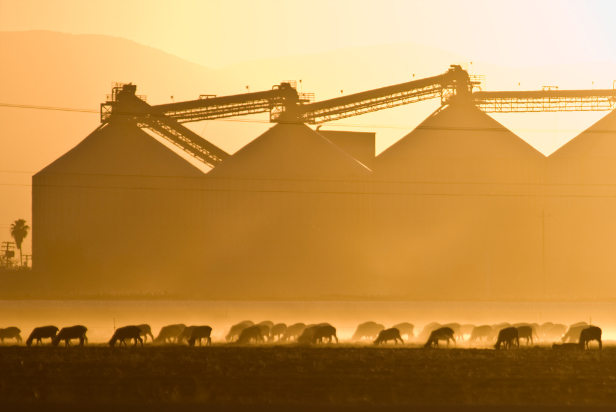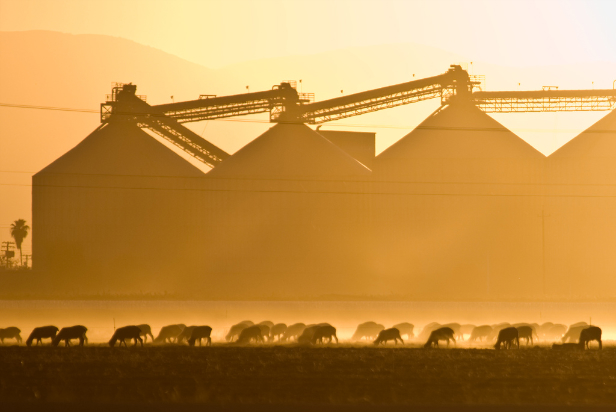 Courtesy Stewart via Flickr
Courtesy Stewart via Flickr
Michael Pollan ended The Omnivore’s Dilemma with this line: “we eat by the grace of nature, not of industry, and what we’re eating is never anything more or less than the body of the world.”
Sustenance, it seems to me, has always been humanity’s most persistent and direct link to the landscape. But at least since the rise of agriculture 10,000 years ago, class relations have had the power to obscure that link. It’s doubtful, for example, that Queen Victoria knew very much about what it took to supply her table, which (telegraphing today’s food-miles debate) included delicacies from all over Britain’s massive empire.
Even Victorian-era Britain’s notoriously exploited workers enjoyed class privilege of a sort. They received a huge portion of their calories from sugar–grown and processed under dire conditions by out-of-sight, out-of-mind black workers all the way in the West Indies, as the anthropologist Sidney Mintz shows in his great book Sweetness and Power. One shudders contemplating the vast swaths of carbon-sucking tropical forest that came under the ax to make way for those sugar plantations.
The rise of industrial agriculture in the 20th century dramatically expanded our distance from the processes that sustain us. In a sense, most of us now live like royalty–separated from the land, as removed as we choose to be from the drudgery of growing and cooking food, with the ability to procure food from dizzying distances with little more than a finger snap.
It’s because of this separation from the land, I think, that food has been slow to catch on as an issue for the modern environmental movement. From the start, of course, there were rumblings that how we feed ourselves exerts a huge environmental impact. Rachel Carson‘s landmark Silent Spring (1962) revealed dirty secrets about what agricultural pesticides were doing to ecosystems; and Frances Moore Lappé‘s Diet for a Small Planet (1971) delivered a cogent, ahead-of-its time look at the vast ecological footprint of meat.
Despite the popularity of these books and the stirrings they created, food mainly stayed at the margins of environmental debate. The first Earth Day celebrations focused on population growth, industrial pollution, and threats to wildlife. Activists likely plotted them over Big Macs of beef from the nation’s emerging corn-sucking feedlots, jacked up on coffee from vast mono-crop plantations in Brazil. Food was merely fuel for the body; protecting the environment meant saving the whales.
Over the past five years, food has moved much closer to the center of the movement. Probably the signal moment was the publication of Livestock’s Long Shadow in fall 2006, a lengthy report by the UN’s Food and Agriculture Organization (FAO). The report, lavishly documented and bluntly written, delivered a bombshell whose full effects we have yet to see the last of: “The livestock sector is a major player [in global climate change], responsible for 18 percent of greenhouse gas emissions measured in CO2 equivalent. This is a higher share than transport.”
A higher share than transport. From that point on, it became impossible to credibly discuss climate change without discussing food. Not that policymakers don’t try. The draft Markey-Waxman legislation, which would cap greenhouse gas emissions, stunningly exempts agriculture from regulation. In doing so, the bill’s sponsors are bowing to the influence of the agriculture lobby, which has brazenly demanded (PDF) that not only should the greenhouse gas emissions generated by industrial farming not be capped, but that its alleged carbon-sequestration services be fully credited.
Official acceptance of such claptrap may soon crumble under the weight of its absurdity. Another recent study (PDF) may prove even more important than the FAO report, even if it lacks its headline-grabbing power. The paper, published by the International Council for Science (ICSU), examines the impact of the synthetic nitrogen fertilizer on which industrial agriculture relies. Scientists have long known that a portion of that fertilizer enters the atmosphere as nitrous oxide, a gas with nearly 300 times more heat-trapping power than carbon. The question is, how much? Most climate assessments, including the International Panel on Climate Change (IPCC) and the FAO’s livestock study, have assumed about 1 percent of fertilizer turns into nitrous oxide. But the ICSU paper pegs the true level at 4 percent or as much as 5-meaning that old estimates may be dramatically undercounting agriculture’s role in climate change.
As the political class lurches toward acceptance of this harsh reality, the rapidly converging environmental and sustainable-food movements still have plenty of work ahead of them.
The main task, I think, is ramping up accessibility. Historically, people of limited means have tended to scrape by on what’s locally available, while the wealthy have used their resources to draw in fancy food from far away. Now, that situation has turned upside down. Micro-farms dot the areas outside metropolises, producing hand-picked, highly nutritious, and pungent microgreens to be plopped on lawyers’, accountants’, and high-tech professionals’ plates for astronomical prices. Meanwhile, the people who staff the vast services economy get the dreck served up by environmentally abusive companies like Smithfield Foods.
At this point, no more than 3 percent of the food consumed in the United States is grown under ecologically sustainable conditions, the Kellogg Foundation estimates. We’ve created a greenhouse gas-intensive, lavishly subsidized system for delivering cheap food to a public that has seen real wages stagnate since the 1970s — and that is now enduring the worst economic crisis since the Great Depression.
Under such conditions, simplistic calls for people to “pay the true cost” of their food aren’t enough. We need to figure out new economic models to make sustainably produced food a viable option for everyone. For food to reach its full potential as a green issue — for our society to feed itself in a way that’s not literally destroying our habitat — that’s our challenge going forward.


